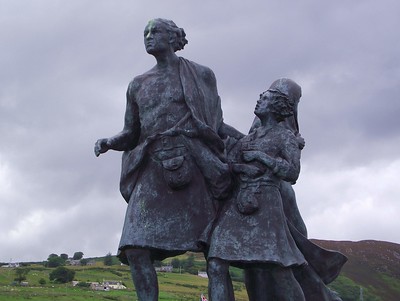Summary | Excerpt | Reading Guide | Reviews | Beyond the Book | Read-Alikes | Genres & Themes | Author Bio

A Novel
by Carys DaviesThis article relates to Clear
 In Clear, the third novel from Carys Davies, an impoverished presbyterian minister reluctantly takes part in the Highland Clearances, a series of mass evictions that took place in the north of Scotland between 1750 and 1850, driven in part by the restructuring of British society during the Industrial Revolution and the collapse of the traditional clan system that had for centuries governed Highland life. The impact on Scotland was profound—and the aftershocks still felt to this day. As the historian Tom Devine has written, the events have become "firmly embedded in the cultural identity of the nation."
In Clear, the third novel from Carys Davies, an impoverished presbyterian minister reluctantly takes part in the Highland Clearances, a series of mass evictions that took place in the north of Scotland between 1750 and 1850, driven in part by the restructuring of British society during the Industrial Revolution and the collapse of the traditional clan system that had for centuries governed Highland life. The impact on Scotland was profound—and the aftershocks still felt to this day. As the historian Tom Devine has written, the events have become "firmly embedded in the cultural identity of the nation."
The Clearances broadly took place over two waves. During the first, which lasted from around 1750 to 1815, Highland landowners decided to take individual crofts—small plots of arable land held in tenancy—and combine them into larger, more profitable sheep farms. Loath to give up the cheap labor of crofting communities that had for generations farmed the land, landlords rehoused many tenants on the coast. Once there, Highlanders were encouraged to take up fishing and kelping, two industries in which they often had no knowledge or expertise.
The second wave of the Clearances began in the 1820s and is associated with a series of market crashes, widespread famines, and outbreaks of cholera. Faced with starvation and death, many families finally chose to emigrate abroad or move to the new urban centers in the south. Landlords too began to favor emigration for their tenants, no longer seeing a financial benefit in supporting them through years of hardship. While some crofters were offered and accepted economic incentives to leave, others were violently evicted. In Sutherland, site of the most infamous evictions, women and children were chased from the land as their homes were set on fire.
Given the cruelty with which some evictions were carried out—not to mention the undeniable racism against the Gaelic population which was used as a justification for that cruelty—the Clearances eventually became a cause célèbre in the south. Even Karl Marx, then living in London, took an active interest. Throughout the 1850s, he decried the wealthy landowners who pursued "the ruin and […] expropriation of the Scotch-Gaelic population from its native soil."
An act of parliament assured remaining crofters security of tenure in 1886. In 1963 the events of the Clearances resurfaced with the publication of John Prebble's hugely successful history, The Highland Clearances. A former member of the Communist Party of Great Britain, Prebble shared Marx's view; in his retelling, the story of the Clearances was one of callous profit, where clan chiefs leaped at the chance to sacrifice their people in the name of self-enrichment.
To this day, The Highland Clearances remains, according to the Guardian, "the most popular Scottish history book ever written." Prebble has had enormous influence on how Scots themselves interpret this period of their history—to the extent that any deviation from his account can be controversial. But despite capturing the public imagination, the simplicity of the story Prebble tells has long been challenged in academic circles, such as by the historian Tom Devine, who in his 2018 study, The Scottish Clearances, looks beyond avarice as the sole motivating factor for the Clearances and contextualizes the widespread coercion and expulsion that took place within the shifting economic factors of the time.
The history of the Highland Clearances is still being written and its uncomfortable legacy still being processed. Artistic interpretations like Carys Davies's Clear play a valuable role, and it's no coincidence that some of the best works of Scottish literature—Neil Gunn's Butcher's Broom, for example, or Iain Crichton Smith's Consider the Lilies—wrestle with them. Highland communities and Highland culture never recovered from the Clearances, at least not in Scotland. There are more descendants of crofters in America and Australasia than in their homeland. The Highland glens remain largely empty, the people outnumbered by sheep to this day.
The Emigrants statue at Helmsdale, Sutherland in Scotland
Photo by Dave Conner (CC BY 2.0)
Filed under People, Eras & Events
![]() This "beyond the book article" relates to Clear. It originally ran in April 2024 and has been updated for the
March 2025 paperback edition.
Go to magazine.
This "beyond the book article" relates to Clear. It originally ran in April 2024 and has been updated for the
March 2025 paperback edition.
Go to magazine.
Your guide toexceptional books
BookBrowse seeks out and recommends the best in contemporary fiction and nonfiction—books that not only engage and entertain but also deepen our understanding of ourselves and the world around us.